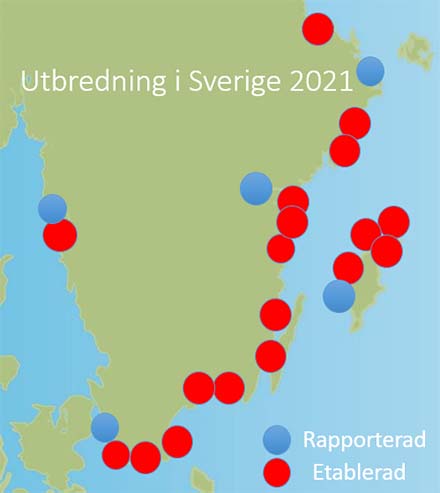The round goby is an invasive fish species spreading quickly and now established along parts of the Swedish coast. It may outcompete native bottom-dwelling species. Report any sightings via Artportalen or the Rappen app to help track its spread.
The round goby (Neogobius melanostomus) originates from the Black Sea and the Caspian Sea. It likely spread to the Baltic Sea through ballast water from ships. In 2008, it was first discovered in Sweden, in the Karlskrona archipelago. The species is now well established there, as well as in Gothenburg, Visby, Kalmar Sound, and the southern Stockholm archipelago. In 2020, it was found in large numbers in the Bay of Gävle, the northernmost sighting in Sweden to date.

Round goby populations grow rapidly after establishment
The round goby is highly adaptable, reproduces quickly, and easily finds both shelter and food. Once established in an area, its numbers often increase rapidly. In the Bay of Gdańsk, where it was first found in the late 1990s, it now completely dominates the coastal fish fauna.
During SLU Aqua’s survey in Karlskrona in July 2015, 162 round gobies were caught at 29 of 45 sites. In 2009, only nine individuals were caught in the same type of survey. Similarly, the round goby population increased sharply in our monitoring of the area near Muskö in the southern Stockholm archipelago up to 2017. After the extremely warm summer of 2018, fewer gobies were caught than expected, but it remains to be seen whether this is a true population decline or if the fish simply moved to deeper waters earlier than usual.

Report sightings of round goby!
As the round goby becomes more common, the risk increases that it will establish itself in more locations across Sweden.
If you catch what you suspect is a round goby, you can help us track the species’ spread. Report your sightings via the Rappen app or at www.artportalen.se.
The round goby should not be confused with native species (see slideshow).
Limiting the spread of round goby
Eradicating the round goby once it has become established is practically impossible, but its spread can be limited. SLU Aqua and Enetjärn Natur, commissioned by the Swedish Agency for Marine and Water Management, have developed a knowledge base on the round goby, published in 2021.
The round goby primarily spreads through ship traffic. Cleaning ship ballast water would likely have the greatest impact, but boat washing when moving boats from coastal to inland waters could also help limit its spread. Stronger predator fish populations would likely reduce the risk of round goby establishing in new areas. A research project is investigating ways to limit its spread and density, aiming to transform the Round goby–turning risk into resource.






